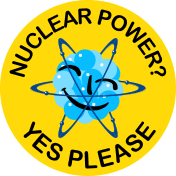Thorium and the nuclear fuel cycle
There are five basic fission fuels. Three are what is called fissile materials : they can start and sustain a chain reaction all by themselves. Two are fertile materials, which can be converted into fissile materials, but cannot sustain a chain reaction on their own. The fissile materials are uranium-233, uranium-235, and plutonium-239, and the fertile materials are thorium-232 and uranium-238.
Of the fissile materials, only 235U occurs in nature, to the extent of 0.7% in natural uranium. The remainder is 238U, which can capture a neutron and be converted (through two successive β decays) to 239Pu. If a fission chain reaction can be started in natural uranium (it can, with graphite or heavy water as moderator), and if the fission of 235U yields more than two neutrons (it does, 2.44 on average), it would appear that the available supply of fissile material can be continuously increased (what is known as ‘fuel breeding’), since the neutrons beyond the one per fission required to keep the chain going can be applied to the transmutation of uranium. Alas, things are not so simple.
To the mechanics of the chain reaction, neutrons emitted per fission is a less important number than neutrons emitted per neutron absorbed, and for natural uranium that value is about 1.6 for slow neutrons (and even less for fast neutrons, so that a chain reaction cannot be supported at all). Therefore, the ‘conversion ratio’ or number of new fuel atoms produced per fuel atom consumed is always less than unity, and the fissile material will ultimately be exhausted while there is still fertile material present. This could be overcome by the costly and laborious process of fractionating the uranium into an ‘enriched’ moiety containing a higher proportion of 235U, and a ‘depleted’ moiety containing less, to improve the chance that a given neutron will cause fission ; but another obstacle appears.
Plutonium-239 releases 2.88 neutrons per fission on average, but it also has a nasty tendency to absorb a neutron and not disintegrate. This produces 240Pu, which is not fissile, but is converted to fissile (albeit short-lived) 241Pu by absorbing a second neutron. This process continues, so that more neutrons are wasted in creating ever-heavier isotopes of transuranic elements such as americium and berkelium than are put to use converting 238U. As a result, the conversion ratio (the number of new fissile nuclei produced per fission) in a thermal reactor using uranium-plutonium fuel never reaches unity ; the overall quantity of fissile material constantly decreases, and fresh fuel is required long before the theoretical maximum of energy is produced.
Breeder cycles
There is a known solution to this problem. The ‘parasitic absorption’ occurs much more strongly with slow than with fast neutrons. The plutonium can be chemically separated and put to use in an unmoderated reactor, where its large excess neutron yield will serve to produce additional 239Pu from 238U quite efficaciously. It is not even necessary to perform the separation before the plutonium has a chance to absorb too many excess neutrons — the higher transuranics also make adequate fuel for a ‘fast reactor’, so that the uranium can be left in the thermal reactor until it has achieved a high fuel value.
Unfortunately, such reactors have proven difficult to make work. Furthermore, early techniques for separating plutonium from irradiated uranium were intended for producing bomb material. Not only was little attention given to cost-effectiveness for power-plant use, or even to recycling the uranium, but the whole subject of ‘reprocessing’ became tainted with the idea of atomic weapons — even though the accumulation of higher isotopes tends to make plutonium from thermal power reactors less than suitable for such uses. Consequently, much of that plutonium simply sits, along with the used uranium, in spent fuel casks, awaiting a political (rather than an engineering) solution. Where plutonium is used for power production, it mostly goes into thermal reactors, mixed with uranium, giving mediocre results. Even a mediocre nuclear fuel is still very good, but the result is that new uranium is constantly required, and unusable spent fuel continues to accumulate, although more slowly.
Thorium offers another path to sustainable atomic energy. Thorium in nature is composed almost entirely of the isotope 232Th, which has a half-life of fourteen billion years. Since this is close to the present age of the universe, and heavy elements are being formed constantly by stellar nucleosynthesis, we can say that more thorium exists now than has ever existed in the past, and the quantity is increasing. More to the point, it is considerably more plentiful in the crust of the Earth than uranium, and quite readily obtained from sources such as monazite sand.
Uranium-233 is produced by neutron capture in 232Th, in a manner exactly analogous to the production of 239Pu from 238U (although thorium is the stronger absorber), and releases 2.50 neutrons per fission. Better yet, its tendency to absorb a thermal neutron is less, giving a net 2.31 neutrons per neutron, as against 2.08 for either 235U or 239Pu. The picture is complicated by parasitic absorptions in the intermediate nuclide 233Pa (half-life 27 days), but this poses no insuperable problems. Hence, thorium irradiated with neutrons from uranium or plutonium fission will tend to accumulate 233U, and will ultimately become enriched enough in fissile material to support a chain reaction in a thermal reactor. When that fuel is used, its proportion of fissile material will continue to increase, and the excess can be separated, mixed with fresh thorium, and used as fuel for additional reactors.
Thorium can be used in existing power reactors. Thorium is often discussed as a prospect for use with technologies such as the molten-salt reactor, which are not in commercial use, and would generally require some degree of research and development, followed by the construction of entirely new power plants. This makes the widespread use of thorium appear as a remote prospect.
In fact, however, thorium-uranium fuels are nothing new. From an early period, at plants such as Indian Point, Peach Bottom, and Fort St Vrain, thorium was mixed with enriched uranium as a sort of extender, to provide a longer fuel life from a given amount of 235U than would 238U. From 1977 until its decommissioning in 1982, the Shippingport plant in Pennsylvania (America’s first full-scale utility atomic power station) operated as a Light Water Breeder Reactor, using a thorium-uranium core, with a small but appreciable production of excess fissile material.
The experience of Shippingport shows that existing light-water reactors, which comprise most of the atomic power capacity in America, France, Japan, and much of the rest of the world, might reasonably be converted to thorium-based fuel now. Work on Th-U and Th-Pu fuels for heavy water reactors is also well in hand. The breeding performance will not be as good as with purpose-designed plants, and periodic reprocessing will still be required, but the buildup of unusable fuel (including depleted uranium from enrichment plants) will stop. If desired, depleted uranium could even be re-enriched with 233U. This is especially attractive in the period after proper thermal breeders have been deployed, but before existing reactors have reached the end of their useful lives or fast breeders have become common.

